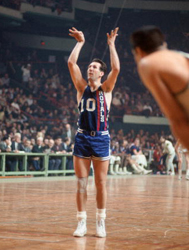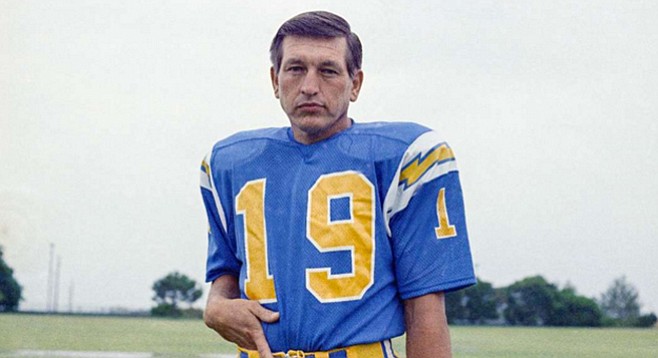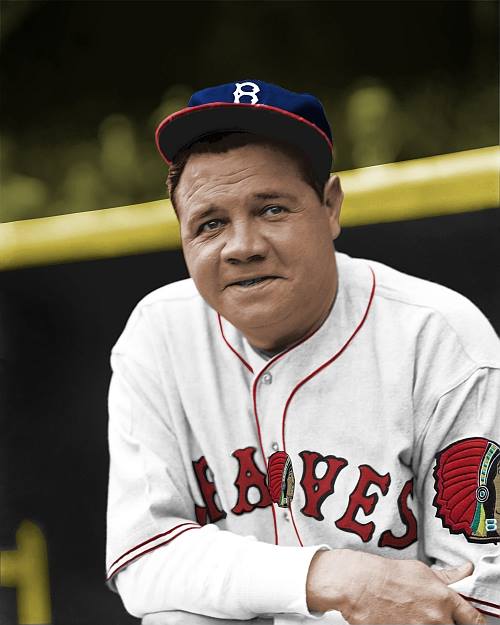"This was a bad idea. I guarantee it."
Eli Manning retired today. At his press conference, he quoted former New York Giants owner Wellington Mara: "Once a Giant, always a Giant," and added, for himself, "Only a Giant."
He looked done this season. Even if he's not, even if he has 1 good season left, it's still good that he retired. It's better to retire a year too early than a year too late.
There's the risk of injury. Then there's the risk of looking like some guys who really shouldn't have hung on as long as they did, and switched teams to do it.
Top 10 Players Who Just Looked Wrong In Those Uniforms
Honorable Mention to Hank Aaron with the Atlanta Braves, 1972 to 1974. True, he was still a legitimate All-Star at the time. But that uniform! Ye gods! It's a shame that he hit Number 715 in it. For being a black man threatening, and finally breaking the record, he got death threats, but whoever designed the uniform got away scot-free.
He spent his last 2 seasons, 1975 and 1976, back in his previous city, with the Milwaukee Brewers. He didn't play as well, but he had a better uniform, even if it was powder blue on the road.
At the 1976 All-Star Game in Philadelphia.
The black armband on Mays' sleeve is for Casey Stengel.
The cap is in honor of the National League's 100th Anniversary.
Honorable Mention to Steve Garvey with the San Diego Padres, 1983 to 1987. He definitely hung on for 1 year too long, but until then, he was still hitting fairly well for the Padres.
But a Padre fan I know from online reminded me of the real reason he should be on this list: His classic description of his uniform change from Los Angeles to San Diego: "When I was a Dodger, I looked at myself in the mirror, and I looked like an American flag. Here, I look like a taco."
Ex-Yankee Graig Nettles and ex-Cardinal Garry Templeton
don't look thrilled by these togs, either.
Honorable Mention to several soccer players who went to the old North American Soccer League in the 1970s, for one big payday at the end of their career, but weren't seen by as many people due to the comparative lack of coverage.
Among them were Pelé and Franz Beckenbauer with the New York Cosmos; George Best and Johan Cruyff with the Los Angeles Aztecs; Best, Gordon Banks and Gerd Müller with the Fort Lauderdale Strikers; Cruyff with the Washington Diplomats; Bobby Moore with the San Antonio Thunder and the original Seattle Sounders; Charlie George with the Minnesota Kicks; and Eusébio with the Boston Minutemen, the Toronto Metros, the Las Vegas Quicksilvers, the New Jersey Americans and the Buffalo Stallions.
10. Patrick Ewing with the Seattle SuperSonics, 2000-01, and the Orlando Magic, 2001-02. This stings less because he didn't win a title with the Knicks, and he wasn't that bad. Still, it was weird.
To be fair, this uniform looked weird no matter who wore it.
Honorable Mention to Walt Frazier with the Cleveland Cavaliers, 1977-80. Seriously? Clyde with the Cavalosers? Only the last season was bad, though.
9. Bob Cousy with the Cincinnati Royals, 1970. Having last played in 1963 with the Boston Celtics, Cooz went into coaching, first at Boston College, and then with the Royals. In the 1969-70 season, the team was losing, and tickets were not selling. He was 41 years old and hadn't played in nearly 7 years, but he thought he could help.
Did he? At the box office, yes: Ticket sales jumped by 77 percent. On the court, no: He played 34 minutes over 7 games, scoring 5 points. "The Houdini of the Hardwood" proved that his heart was in the right place, but his legs were nowhere to be found. The team moved to become the Kansas City Kings in 1972, and he resigned as head coach in 1973, never to coach again.
Lucky for him, there was no ESPN to cover his sad efforts, or else we might have had a situation like in the movie Mr. 3000, with Bernie Mac as a 47-year-old baseball player thinking a comeback might get him the 3,000th career hit he thought he had, and into the Baseball Hall of Fame. Cooz was elected to the Basketball Hall of Fame in 1971, after his 2nd retirement.
I had considered including another Celtic legend on this list: Dave Cowens, with the Milwaukee Bucks in 1982-83, under his former Celtic teammate Don Nelson, 2 years after his 1st retirement. But he actually did all right for the Bucks, averaging 8.1 points per game at age 44, and helping them win 51 games. But he got hurt in the last regular-season game, and never played again. Ironically, with him unavailable to either team, the Bucks beat the Celtics in the 1st round of the Playoffs.
8. Duke Snider with the San Francisco Giants, 1964. The Duke, his former Brooklyn Dodger teammate Gil Hodges, Warren Spahn, Richie Ashburn, and even Yogi Berra, coming off the coaching staff to play 4 more games in 1965, all played with the Mets at or near the ends of their careers. (Spahn also closed it out with the Giants.)
The Duke playing in Los Angeles with the Dodgers wasn't that big a deal, since it was his hometown. But the Duke playing for the Giants? In San Francisco? That was so wrong, it should be said with a "hard G": "That's just wrong-guh."
He played in 91 games, batted just .210, hit 4 home runs and had only 17 RBIs. He was 38 and not injury-prone, so he should have had something left. But if he did, Candlestick Park was not the place to show it.
7. Michael Jordan with the Washington Wizards, 2001-03. When he made his 1st comeback in 1995, he was 32, and no one was worried that he was making a mistake. Besides, it was still with the Chicago Bulls. But when he made his 2nd comeback, he was 38, he'd taken 2 1/2 years off, and was signing with... the Washington Wizards? A team that hadn't mattered in 20 years, since they were the Washington Bullets?I had considered including another Celtic legend on this list: Dave Cowens, with the Milwaukee Bucks in 1982-83, under his former Celtic teammate Don Nelson, 2 years after his 1st retirement. But he actually did all right for the Bucks, averaging 8.1 points per game at age 44, and helping them win 51 games. But he got hurt in the last regular-season game, and never played again. Ironically, with him unavailable to either team, the Bucks beat the Celtics in the 1st round of the Playoffs.
8. Duke Snider with the San Francisco Giants, 1964. The Duke, his former Brooklyn Dodger teammate Gil Hodges, Warren Spahn, Richie Ashburn, and even Yogi Berra, coming off the coaching staff to play 4 more games in 1965, all played with the Mets at or near the ends of their careers. (Spahn also closed it out with the Giants.)
The Duke playing in Los Angeles with the Dodgers wasn't that big a deal, since it was his hometown. But the Duke playing for the Giants? In San Francisco? That was so wrong, it should be said with a "hard G": "That's just wrong-guh."
This photograph, and this card, are totally real.
They shouldn't have been.
He played in 91 games, batted just .210, hit 4 home runs and had only 17 RBIs. He was 38 and not injury-prone, so he should have had something left. But if he did, Candlestick Park was not the place to show it.
Yes, he announced he was donating his entire salary to 9/11 relief efforts (he announced his comeback 2 weeks after the attacks), so that was going to help. But the question was asked: "Will this comeback destroy Michael Jordan's legacy?"
In 2001-02, he battled injuries, especially to his knee, and was limited to 60 games, although he did lead the Wiz in scoring with 22.9 points per game. That should have been it. It wasn't. He played in all 82 games in 2002-03, and averaged 20.0 points, including 3 games of at least 40 points. Every Wizards home game was sold out.
But he publicly criticized his teammates, and he was not in the best of positions to do so. This was not the Jordan of 1996, or even of 1998. And fans saw him on ESPN's SportsCenter every night, looking like less than His Airness.
When Epic Rap Battles of History brought on the comedy team of Keegan-Michael Key to play Jordan, and Jordan Peele to play Muhammad Ali, Ali said to Jordan, "Your whole basketball career turned wack, when you came back a Wizard, like Gandalf the Black!" No, it wasn't a Mr. 3000 situation, and it didn't "destroy his legacy." But it did tarnish the legacy.
6. Steven Gerrard with the L.A. Galaxy, 2015-16. Due to the growth of telecasts of soccer, no player, not even 1970s-'80s great Kenny Dalglish, has become as identified with Liverpool Football Club as Stevie G. But for all he achieved with the Mersey Reds, he never won the Premier League.
So, at the age of 35, after 17 seasons with his hometown team, he went to Carson, California, to the Gals, who had 3 of the last 4 MLS Cups and 5 of the last 13. Surely, there, he could win a league. Result: They were eliminated in the 1st round in 2015 and the Conference Semifinals in 2016. And he retired. Oh well.
Dishonorable Mention to 2 other European legends, who played in MLS in the 2018 and '19 seasons: Zlatan Ibrahimović with the Galaxy, who at least scored a few goals; and Wayne Rooney with D.C. United.
What he said in his retirement ceremony the previous month at Shea Stadium was something he should have said after that return homer: "Willie, say goodbye to America."
4. Joe Namath with the Los Angeles Rams, 1977. I understand going to Hollywood, but with those knees, Joe should've retired a couple of years earlier. And those garish blue and yellow (not "gold") uniforms were so wrong for him. He played in 4 games, completed 46.7 percent of his passes, threw 3 of them for touchdowns, and 5 for interceptions.
I once saw a Mad magazine which showed "Joe Nomyth" (as in, "no myth") interviewing a judge who turned out to be corrupt. He asked the judge, "What kind of cases do you enjoy most?" The judge said, "Pornography cases! I have to view all the films to see if they're obscene! Isn't this great?" And Joe said, "It sure beats looking at old football films. Except for the last few games of my career, which really were obscene!" They say all great humor is rooted in truth. It certainly was on that occasion.
I had considered including Brett Favre, who played for the Jets in 2008 and the Minnesota Vikings in 2009 and '10. But, as weird as he looked in those teams' uniforms, rather than those of the Green Bay Packers -- and, keep in mind, the Vikings are 2nd to the Chicago Bears as the Packers' rivals -- he actually made the Pro Bowl in 2008 and '09. In 2009, turning 40 during the season, he had the highest completion percentage of his career, a League-leading 68.4 percent, and threw 33 touchdown passes and only 7 interceptions.
Even in his last season, with an awful ratio of 11 touchdown passes and 19 interceptions, he still completed 60.6 percent of his passes. He may have hung on 1 year too long, but he still had something left when he got to Minneapolis, never mind the Meadowlands.
3. Johnny Unitas with the San Diego Chargers, 1973. In Baltimore Colts blue and white, he looked more like a quarterback than anyone ever has. In Charger blue and yellow (again, not "gold"), he looked like an old man in a Hawaiian shirt and Bermuda shorts going for the early bird special in Florida.
He appeared in 5 games, completed 44.7 percent of his passes, threw 3 touchdown passes and 7 interceptions. And while he had a bad back, it wasn't as bad as Broadway Joe's knees. Plus, given that he was better than Namath, it was more of a comedown for him. About the only thing Johnny U got out of his San Diego experience was good weather.
I also considered O.J. Simpson with the San Francisco 49ers in 1978 and '79 (he gained 1,000 yards in 2 seasons, and it was his hometown team, although he was only 32 at the end), Thurman Thomas with the Miami Dolphins in 2000 (an injury-riddled last season with an AFC East rival of the Buffalo Bills), and Jerry Rice with the Seattle Seahawks in 2004 (the greatest career, statistically speaking, in NFL history finally ran out).
2. Bobby Orr with the Chicago Blackhawks, 1976-78. In 1976, the Boston Bruins offered Orr's agent, Alan Eagleson, a contract that would have sold him 18 percent ownership in the franchise in 1980. Eagleson turned the offer down -- without even telling him, Orr said. This was inexcusable. It's one reason why Eagleson was a crook, and is the only man who has ever had to resign membership in his sport's Hall of Fame: Because he defrauded the players he was working for, including Orr and other Hall-of-Famers.
Eagleson was a friend of Blackhawks owner Bill Wirtz, who offered Orr a contract. He played a grand total of 26 games for Chicago, limited by injury, and retired at age 30. This is how I remember Bobby Orr: Not as the greatest player of his generation, not as the biggest reason the Bruins won 2 Stanley Cups (1970 and '72, the only ones they won between 1941 and 2011), but as a broken-down Blackhawk. I knew that was a shame even before I knew how Eagleson had arranged it.
1. Babe Ruth with the Boston Braves, 1935. The ultimate example. The greatest player in the history of the greatest sport, and he ended up a fat, injured DH on a 115-loss team in a league that didn't have the DH (and still doesn't).
I don't blame him for wanting to go back to his first major league city. And I don't blame him for believing the promise of also being assistant manager, and manager-in-waiting. Lots of people would have been fooled by that. And, to be fair, he was injured (his elbow), but that game where he hit 3 home runs (at Forbes Field in Pittsburgh, a pitcher's park) showed what he could still do when he felt good.
A few days later, he tripped and fell while chasing a fly ball. There was no designated hitter at the time. The Bambino was done, and he knew it, and retired within days. He was lucky there was no ESPN to show the entire country just how done he was.











No comments:
Post a Comment